A MOSFET (Metal-Oxide-Semiconductor Field-Effect Transistor) amp is a type of amplifier that uses MOSFETs as the primary active components for amplification. MOSFET amps are highly regarded in the audio industry for their superior performance, efficiency, and reliability.
These amplifiers are widely used in various applications, including audio systems, musical instruments, and professional sound equipment, due to their ability to deliver clear and powerful sound with minimal distortion.
What is a MOSFET Amp and What Does MOSFET Amp Mean?
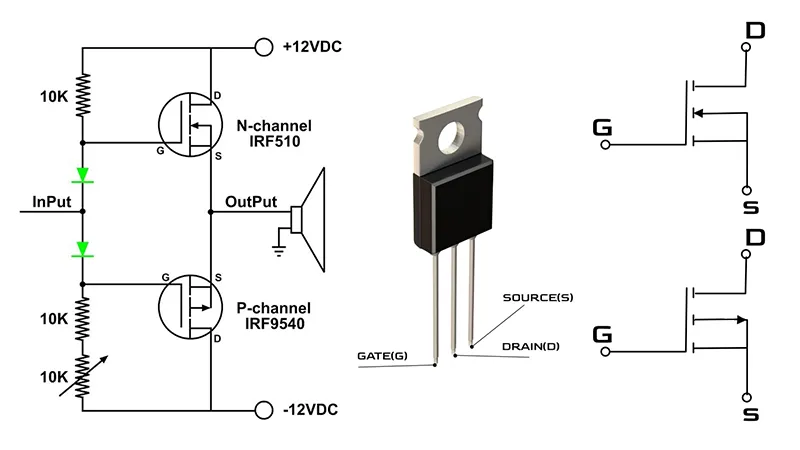
A MOSFET amplifier is a type of electronic amplifier that utilizes Metal-Oxide-Semiconductor Field-Effect Transistors (MOSFETs) as the key active components for signal amplification. MOSFETs are a class of transistors that offer several advantages over traditional bipolar junction transistors (BJTs), making them ideal for high-performance amplifier designs.
What Does MOSFET Amp Mean?
The term “MOSFET amp” refers to an amplifier that incorporates MOSFET technology. Here’s a breakdown of what makes a MOSFET amp distinct:
- High Input Impedance: MOSFETs have a very high input impedance, which means they require very little current to control the output. This characteristic is beneficial in preserving the integrity of the input signal and minimizing signal loss.
- Low Output Impedance: The low output impedance of MOSFETs allows for better power transfer to the load (such as speakers), resulting in more efficient operation and better sound quality.
- Fast Switching: MOSFETs can switch on and off much faster than BJTs. This fast switching capability is essential for high-frequency applications and contributes to the overall efficiency and performance of the amplifier.
- Thermal Stability: MOSFETs are less susceptible to thermal runaway, a phenomenon where an increase in temperature can lead to a further increase in current, potentially causing device failure. This makes MOSFET amplifiers more stable and reliable, especially under high power conditions.
- Efficiency: Due to their construction and operating principles, MOSFETs are more efficient than BJTs. They can handle higher power levels with less heat generation, which is critical for both performance and longevity.
What Does MOSFET Mean for an Amplifier?
MOSFETs bring several advantages to amplifiers that significantly enhance their performance. First and foremost, MOSFETs have high input impedance and low output impedance, which allows for better matching with various audio sources and speakers. This means that a MOSFET amp can more effectively drive a wide range of loads without significant signal loss or distortion.
Additionally, MOSFETs are known for their fast switching speeds and high efficiency. In an amplifier, this translates to a more responsive and dynamic audio performance, capable of handling the rapid changes in audio signals with precision. The high efficiency of MOSFETs also means that they generate less heat compared to other types of transistors, leading to cooler operation and increased reliability over time.
Another key advantage of MOSFETs is their linearity. Linearity refers to how accurately an amplifier can reproduce the input signal without adding distortion. MOSFETs exhibit excellent linearity, which is crucial for maintaining the fidelity of the audio signal. This results in a cleaner, more accurate sound that audiophiles and professionals alike appreciate.
Furthermore, MOSFETs are inherently more robust and less prone to thermal runaway, a condition where an increase in temperature causes a further increase in current, potentially leading to device failure. This makes MOSFET amps more stable and reliable, especially under demanding conditions.
What Are the Applications of MOSFET Amplifier?
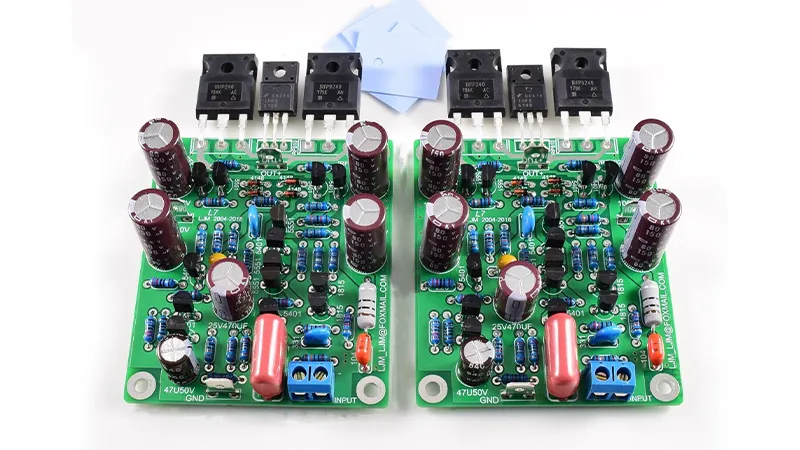
MOSFET amplifiers are utilized in a broad spectrum of applications due to their superior performance, efficiency, and reliability. Here are some of the key areas where MOSFET amplifiers are prominently used:
MOSFET Amplifier Used in Audio Systems
One of the most common applications of MOSFET amplifiers is in audio systems. They are favored in both consumer and professional audio equipment for their ability to produce high-quality sound with minimal distortion. MOSFET amplifiers are used in:
- Home Audio Systems: Providing clear and powerful audio output for home entertainment setups, including speakers, home theaters, and soundbars.
- What is a MOSFET Car Amplifier: Ensuring robust and high-fidelity sound in automotive audio systems, which often require amplifiers that can handle high power levels and deliver consistent performance.
- Professional Sound Equipment: Used in concert halls, recording studios, and live sound reinforcement systems where precise and powerful sound reproduction is critical.
MOSFET Amplifier Used in Musical Instruments
MOSFET amplifiers are also widely used in amplifying musical instruments, particularly electric guitars and basses. Their characteristics make them ideal for:
- Guitar Amplifiers: Offering a range of tonal qualities from clean and clear to rich and distorted sounds, depending on the musician’s preference and playing style.
- Bass Amplifiers: Providing the necessary power and clarity to handle the low-frequency sounds of bass guitars, ensuring that the deep tones are accurately and powerfully reproduced.
MOSFET Amplifier Used in Musical Instruments Radio Frequency (RF)
In addition to audio applications, MOSFET amplifiers are used in radio frequency (RF) applications due to their fast switching speeds and high efficiency. These include:
- RF Transmitters: Used in broadcasting and communication systems to amplify RF signals for transmission over long distances.
- RF Amplifiers: Employed in various RF devices and systems to boost signal strength while maintaining signal integrity.
Industrial Applications
MOSFET amplifiers are also found in various industrial applications where robust and reliable amplification is required. These applications include:
- Power Supplies: Used in switching power supplies and converters, where their high efficiency and fast response times are essential.
- Motor Drives: Employed in controlling and driving electric motors in industrial machinery, providing precise control and efficient power management.
- Medical Equipment: Used in medical devices that require high reliability and precise signal amplification, such as ultrasound machines and diagnostic equipment.
MOSFET Amplifier Used in Communication Systems
MOSFET amplifiers are integral to many communication systems, enhancing the performance and reliability of various communication technologies:
- Cellular Base Stations: Used in amplifying signals in cellular networks to ensure clear and reliable communication.
- Satellite Communication: Employed in satellite communication systems to amplify signals for transmission and reception, ensuring robust and efficient data transfer.
How Can MOSFET Be Used as an Amplifier?
How Do MOSFETs Amplify Current?
At its core, a MOSFET amplifier operates by using the MOSFET to control the flow of current between two terminals—drain and source—based on the voltage applied to a third terminal, the gate. This gate voltage modulates the conductivity of the MOSFET, thereby controlling the output current and amplifying the input signal.
Types of MOSFET Amplifiers
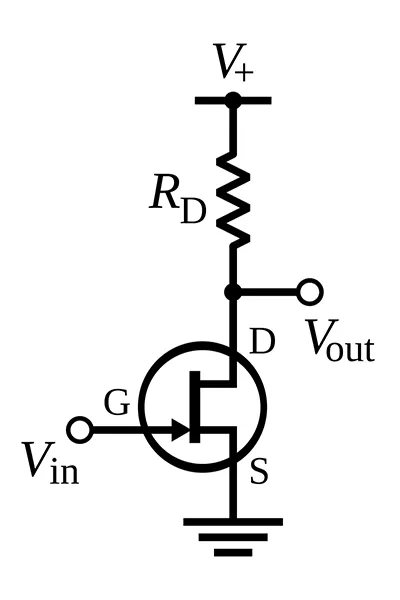
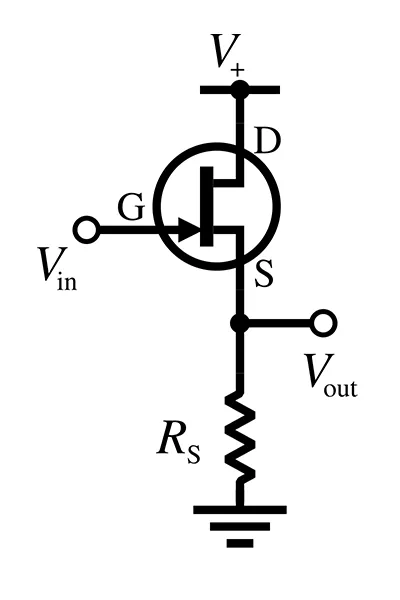
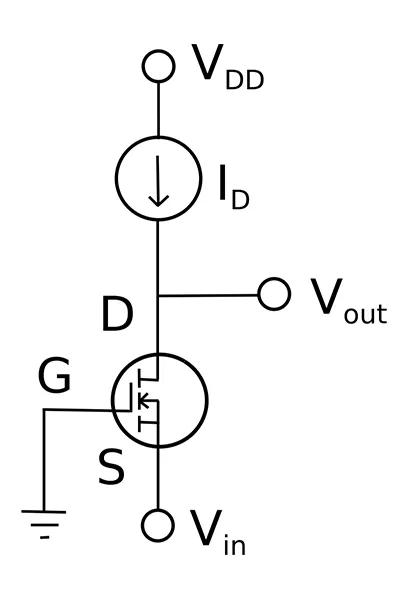
There are several types of MOSFET amplifiers, each suited for different applications and performance requirements:
Common Source Amplifier:
Configuration: The input signal is applied to the gate, the output is taken from the drain, and the source is grounded.
Characteristics: Provides high voltage gain and is widely used in audio amplification and signal processing.
Operation: When a small voltage is applied to the gate, it modulates the current flowing from drain to source, resulting in an amplified output voltage at the drain.
Common Drain Amplifier (Source Follower):
Configuration: The input signal is applied to the gate, the output is taken from the source, and the drain is connected to the supply voltage.
Characteristics: Provides voltage buffering with unity gain (gain ≈ 1) and high input impedance, useful for impedance matching and signal buffering.
Operation: The output voltage follows the input voltage, making it ideal for applications where signal integrity must be preserved.
Common Gate Amplifier:
Configuration: The input signal is applied to the source, the output is taken from the drain, and the gate is grounded.
Characteristics: Provides high frequency response and is used in RF amplification.
Operation: The current flowing through the source modulates the current through the drain, resulting in an amplified output voltage at the drain.
How to Make MOSFET Amplifier?
Creating a MOSFET amplifier involves several steps, from selecting the appropriate components to assembling and testing the circuit. Below is a comprehensive guide on how to make a simple MOSFET amplifier, typically a common source amplifier, which is widely used for its high gain and straightforward design.
Step 1: Gather the Components
To build a MOSFET amplifier, you will need the following components:
- MOSFET: A suitable N-channel MOSFET, such as the IRF540N.
- Resistors: Various resistors for biasing and setting the gain (e.g., 10kΩ, 1kΩ, 100Ω).
- Capacitors: Coupling and bypass capacitors (e.g., 10μF, 100μF).
- Power Supply: A DC power supply appropriate for your MOSFET (e.g., 12V DC).
- Breadboard and Wires: For assembling the circuit.
- Multimeter: For measuring voltages and ensuring proper biasing.
- Signal Source: An audio signal source or function generator.
- Load: A speaker or other load to test the output.
Step 2: Circuit Design
A basic common source MOSFET amplifier circuit is designed as follows:
- Gate Resistor (R1): Connected between the signal source and the MOSFET gate. It ensures proper biasing and stability.
- Drain Resistor (R2): Connected between the MOSFET drain and the power supply. It sets the output voltage and helps in determining the gain.
- Source Resistor (R3): Connected between the MOSFET source and ground. It provides feedback for stability and linearity.
- Coupling Capacitors (C1 and C2): C1 is connected between the signal source and the gate resistor to block DC and allow AC signals. C2 is connected between the drain resistor and the load to block DC from reaching the load.
Step 3: Assemble the Circuit
Using a breadboard, assemble the circuit according to the design:
- Place the MOSFET: Insert the MOSFET into the breadboard.
- Connect the Resistors: Connect R1 between the gate and the signal source, R2 between the drain and the power supply, and R3 between the source and ground.
- Add Coupling Capacitors: Connect C1 between the signal source and R1, and C2 between the drain (output) and the load.
- Power Supply: Connect the positive terminal of the power supply to the drain resistor and the negative terminal to the ground.
Step 4: Biasing the MOSFET
Proper biasing is crucial for the MOSFET to operate in the desired region:
- Set the Gate Voltage: Adjust the input signal or use a voltage divider network to set the gate voltage at a level that ensures the MOSFET operates in the saturation region.
- Measure Voltages: Use a multimeter to measure the gate, drain, and source voltages. The gate-source voltage (Vgs) should be above the MOSFET’s threshold voltage (Vth) to turn it on.
Step 5: Test the Amplifier
After assembling and biasing the circuit, test the amplifier:
- Apply the Input Signal: Connect the signal source to the input.
- Monitor the Output: Connect the output to a speaker or an oscilloscope to observe the amplified signal.
- Adjustments: If the output is not as expected, adjust the resistor values or biasing to optimize performance.
Conclusion
MOSFET amplifiers offer numerous advantages in terms of efficiency, linearity, and reliability, making them a preferred choice for a variety of applications, including audio systems, musical instruments, RF amplification, and industrial uses.
Understanding the principles of MOSFET operation and following a systematic approach to designing and building MOSFET amplifiers can yield high-performance, robust amplification solutions.
By gathering the necessary components, designing the circuit with proper biasing, and carefully assembling and testing the amplifier, you can harness the full potential of MOSFET technology. Whether you’re an audio enthusiast seeking high-fidelity sound or an engineer working on advanced communication systems, MOSFET amplifiers provide the versatility and performance needed to meet your goals.
Building a MOSFET amplifier is a rewarding experience that deepens your understanding of electronic circuits and their applications. As you continue to experiment and refine your designs, you’ll discover new ways to leverage the unique properties of MOSFETs to create even more efficient and powerful amplifiers.